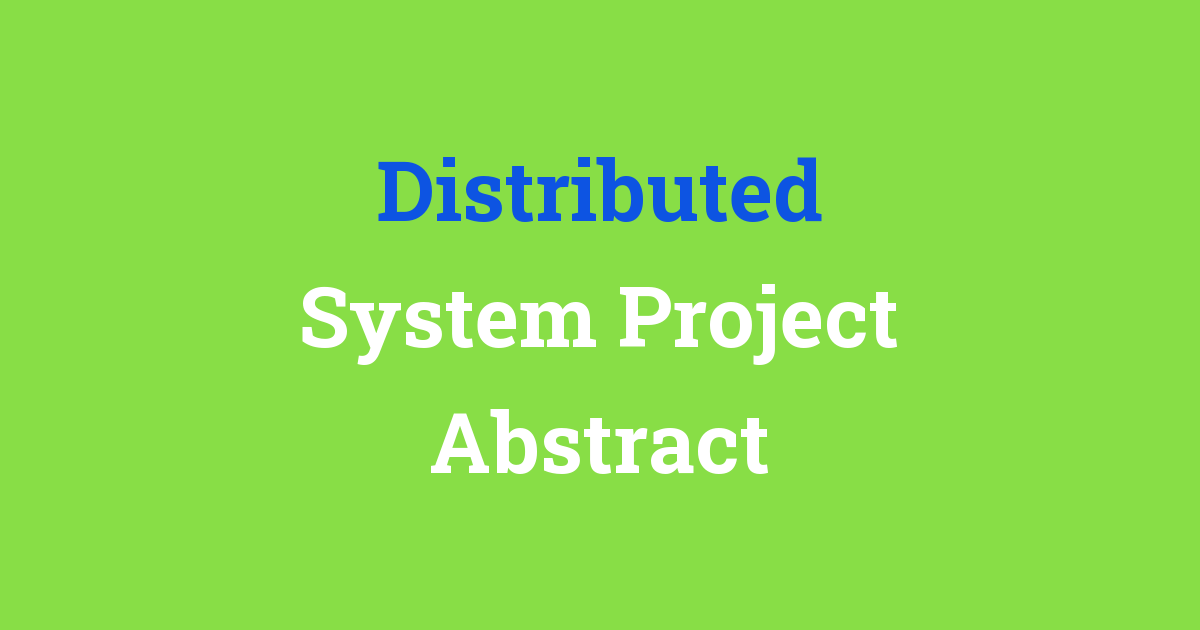The abstract of the distributed system project is as follows:
Introduction
In today’s world, the need for efficient and reliable systems is at an all-time high. With the increase in the amount of data being processed, traditional centralized systems are proving to be inadequate. This has led to the development of distributed systems, which distribute the workload across multiple computers, making them more scalable and fault-tolerant. In this project, we aim to design a distributed system that addresses the limitations of the existing systems and provides a more efficient solution.
Problem Statement
The existing centralized systems are unable to handle the increasing amount of data and processing requirements. They are prone to bottlenecks, single points of failure, and scalability issues. This leads to system downtime, data loss, and inefficiencies in processing. The need of the hour is to design a distributed system that can distribute the workload across multiple computers, handle failures gracefully, and scale easily with the increasing demands.
Existing System
The existing systems are based on a client-server architecture, where a central server controls the flow of data and requests. This architecture has served well for many years but has limitations when it comes to handling large-scale data and processing requirements. The centralized nature of the system makes it prone to bottlenecks, as all requests have to go through a single point. Moreover, if the central server fails, the entire system becomes unavailable.
Disadvantages
The disadvantages of the existing centralized systems include:
1. Scalability issues: The systems are not easily scalable and struggle to handle the increasing demands of data and processing.
2. Single points of failure: The central server acts as a single point of failure, leading to downtime and data loss in case of a failure.
3. Bottlenecks: All requests have to go through the central server, leading to bottlenecks and inefficiencies in processing.
4. Lack of fault tolerance: The systems are not fault-tolerant and fail to handle failures gracefully.
Proposed System
The proposed system is a distributed system that distributes the workload across multiple computers, making it more scalable, fault-tolerant, and efficient. The system will be based on a peer-to-peer architecture, where all computers will act as equals and work together to process and store data. This architecture will eliminate single points of failure and bottlenecks, making the system more reliable and efficient.
Advantages
The proposed distributed system offers several advantages over the existing centralized systems, including:
1. Scalability: The system is easily scalable and can handle increasing demands by adding more computers to the network.
2. Fault tolerance: The system is fault-tolerant and can handle failures gracefully by redistributing the workload to other computers.
3. Efficiency: The distributed nature of the system eliminates bottlenecks, making it more efficient in processing and storing data.
4. Reliability: With no single points of failure, the system is more reliable and available, ensuring continuous operation.
Features
The key features of the proposed distributed system include:
1. Peer-to-peer architecture: All computers in the network act as equals, working together to process and store data.
2. Load balancing: The system distributes the workload evenly across all computers, ensuring efficient processing.
3. Fault tolerance: In case of a failure, the system redistributes the workload to other computers, ensuring continuous operation.
4. Scalability: The system is easily scalable, allowing more computers to be added to the network to handle increasing demands.
5. Data replication: Data is replicated across multiple computers, ensuring data availability and reliability.
Conclusion
In conclusion, the proposed distributed system aims to address the limitations of the existing centralized systems and provide a more efficient and reliable solution. By distributing the workload across multiple computers, the system becomes more scalable, fault-tolerant, and efficient. The peer-to-peer architecture eliminates single points of failure and bottlenecks, making the system more reliable and available. With features such as load balancing, fault tolerance, scalability, and data replication, the proposed system offers a more modern and effective solution for handling large-scale data and processing requirements. This project work has the potential to revolutionize the way systems are designed and implemented, paving the way for a more efficient and reliable future.

